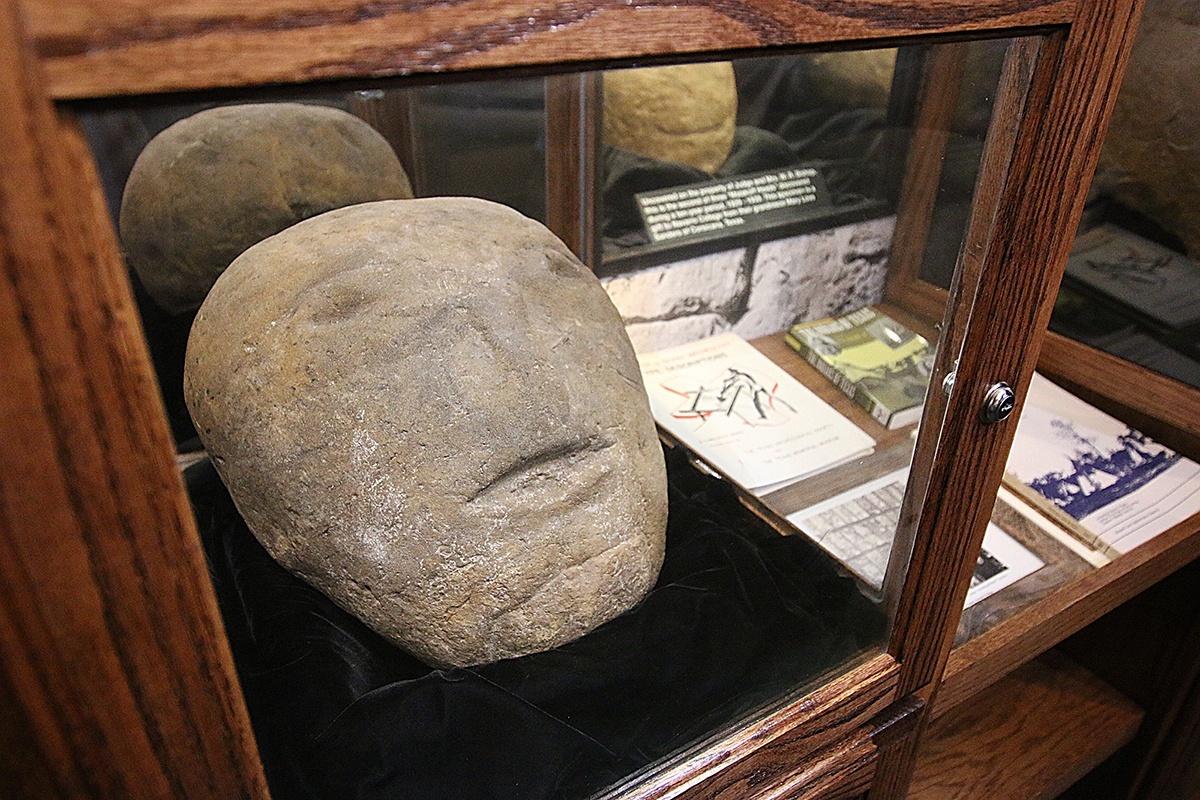Many Texans have long been curious about the large carved heads found near Malakoff, population 2,300, on Texas Highway 31 in Henderson County.
Most visitors drive through Malakoff on their way to Athens or Corsicana. The town dates to the early 1800s and thrived with the arrival of a railroad and the discovery of lignite (brown coal) in 1912. In 1904, Malakoff had nine general stores, three hotels, two grocery stores, three drugstores, a furniture store, two lumberyards, three theaters, a brick company, a butcher shop, six doctors, two barbers, an undertaker and nine builders.
To understand the area’s greatest natural mystery, I check in with Pat Isaacson, director of the Malakoff Historical Society and Museum. The museum occupies a grand house on East Main Street and contains exact casts of the three heads designated as “the Malakoff Man.”
Isaacson explains that in 1929, Thomas Bartlett, owner of Malakoff Pressed Brick Company (now Acme Brick Company), sent a crew to the Trinity River for a load of gravel. The workers knew when they found a 98-pound, 16-inch-long sculpture of a head that “they had something valuable. They brought it back to Mr. Bartlett,” Isaacson says.
Bartlett displayed the head in his store until mining engineer V.C. Doctorman contacted the Texas Memorial Museum in Austin.
According to the Texas State Historical Association, Elias Howard Sellards, geologist and paleontologist, inspected the head and proclaimed it authentic. When a second head was discovered, in 1935, Glen Evans of the University of Texas at Austin decided further excavation was justified. From 1929 to 1939, “they found three heads and the remains of mastodons, camels and sloths as big as steers,” Isaacson says.
To view the original heads, I drive to Corsicana and visit the Pearce Museum at Navarro College. Ann Zembala, museum director, explains that one of the heads was donated to the museum several years ago by Mary Love Sanders, who had inherited the head from her great uncle, who owned the quarry where it was found.
With the help of state Rep. Byron Cook, the other two heads were moved to Corsicana from the Texas Archeological Research Laboratory at the University of Texas.
“They were discovered on the same piece of land within a 10-year time frame, but until now they have never been housed or displayed together,” Zembala says. “Our new Hunter Gatherers of the Blackland Prairie exhibit is the perfect place for the three heads to be on permanent display.”
The exhibit also features 44,000 prehistoric Native American tools and relics, many used for hunting mammoths, buffalo and other animals.
According to the TSHA, Sellards believed the first head came from an Eocene geological formation dating 50,000–100,000 years ago and predates the first-known occupation of the continent by Paleo-Indians. More recent studies, however, show the deposit is Late Pleistocene and dates the heads to the era of the Paleo-Indians. As noted in the Handbook of Texas, other experts place the finds in the Archaic period, 3,000–4,000 years ago, based on a vague similarity to the colossal heads found along the Gulf and made by craftsmen of the Olmec civilization.
Some authorities ignore the validity of the Malakoff Man, while skeptics believe modern metal tools were used to carve the first head.
Another question arises because no other relics were unearthed with the heads. The excavation stopped in 1939 after discovery of the third head. The excavation site was inundated by Cedar Creek Reservoir, a recreational site north of Malakoff. Because no further excavation or research can take place, there always will be speculation surrounding the Malakoff Man. The mystery will remain.
——————–
Marilyn Jones lives in Henderson and writes about travel.


